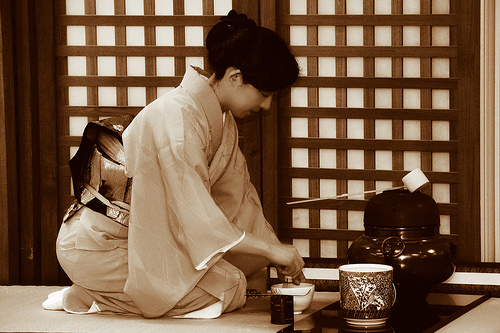I.The Japanese Tea Ceremony
Chanoyu, Sado or Ocha in Japanese refers to the Japanese tea ceremony where green tea known as Matcha is served. It is a ritual that is almost like a dance – with each step and gesture from the host totally focused on the guests who are called Shokyaku. The ceremony is not about drinking tea itself but is all about artistic tea preparation and serving from the heart of the host in honor of his guests. Even the placement of the utensils during the tea ceremony is done with complete regard for the guests.

The tea is served with other Japanese sweets to contrast the bitter taste of the tea.
II. History of the Japanese Tea Ceremony
Serving of tea in China dates back to as early as the third century but it was in the 17th century A.D. that tea seeds were brought to Japan where they were grown in Buddhist temples and drank by monks for medicinal purposes. Green tea remained a rare and expensive commodity in Japan for centuries. – Read more…
III. Types of the Japanese Tea Ceremony
There are several kinds of tea ceremonies held during the year depending on the time of the ceremony, theoccasion for holding the tea ceremony and the current season.
• The Hatsugama 初釜, meaning “first kettle.” which happens in January
• This is a unique occasion being the only time that a tea teacher would serve tea and food for students. – Read more…
IV. Preparing tea
The ritual of tea preparation is very simple; simplicity is one of the defining principles in preparing a bowl of green tea for guests. However, each step of the preparation involves standard movements, and utensils have to be placed at pre-determined locations on the Tatami mat. – Read more…
V. Equipment used during a tea ceremony (temae)
Dōgu refers to equipment used during the tea ceremony. A wide range of dōgu is considered necessary even during a very simple tea ceremony. – Read more…
VI. Tea Ceremony Equipment for Guests
Kaishi paper is brought by all guests and sometimes by the Teishu (host) himself. A stack of Kaishi paper is also placed at chest level in the over-lap of the Kimono. – Read more…
VII. Rank of Tea Ceremony Utensils
Choosing which utensils are to be used during a particular tea ceremony would depend on various factors including the season it is to be held and occasion of the gathering which was earlier explained in the topic of seasons of tea. The manner these utensils are handled depends on the occasion and ranking of the utensils to be used. – Read more…
VIII. Room Preparation for tea ceremony
The Chashitsu must be cleaned. Sweeping is done and wiping of the Tatami floor mats. The Roji garden and the stepping stone path leading from the Koshikake-Machiai to the Chashitsu is also cleaned and swept. – Read more…
IX. Chashitsu Tea Rooms
Different sizes of rooms are named based on the number of Tatami mats inside the room or how they are laid out. A Koma (small room) has four-and-a-half Tatami mats. – Read more…
X. Etiquette for Guests
The standard number of guests for a small meeting is between 4-5. Shokyaku means guest of honor or the first guest while the the second guest is called a Jikyaku and Kyaku are all other remaining guests. – Read more…